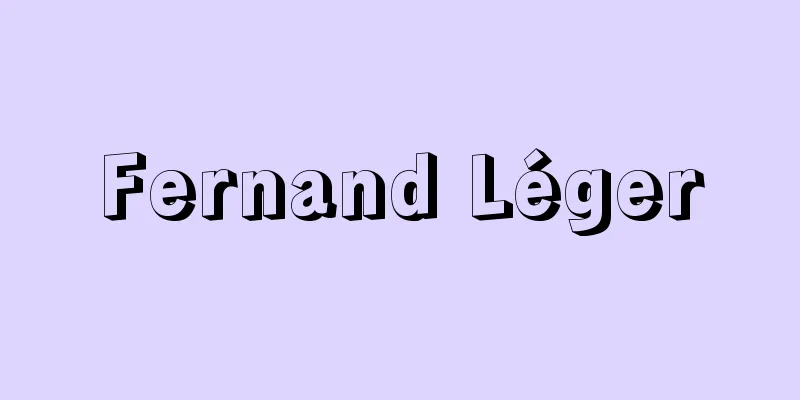Fernand Léger

|
French painter. As a member of the Cubist movement, he played an important role in the development of what is known as Dynamic Cubism, and later created a unique image in 20th century art with his unique style of painting, depicting modern life in which machines and humans coexist in harmony. Born in Argentan, Normandy. He trained as an architect in Caen, and moved to Paris in 1900. He also worked for architects and photographers, and after completing his military service in 1903, he entered the École des Arts Décoratifs in Paris. He also studied under Léon Gérôme at the École des Beaux-Arts and the Academie Julian. Inspired by the Cézanne exhibitions at the Salon d'Automne in 1904 and 1907, he also came into contact with Robert Delaunay and Apollinaire, which led to his approach to Cubism, and the result of this was exhibited in 1909-10 as "Nudes in a Forest" (Otterlo, Kröller-Muller Museum). He continued to develop Cubism, which emphasizes color and dynamism, together with Delaunay and others. In 1912, he had his first solo exhibition at the Kahnweiler Gallery, and served in the First World War, where he was hospitalized due to poison gas. After the war, from 1918 to 1923, he went through what was called his "mechanical period," in which he sought contrast and harmony between form and color through robotic forms and mechanical images such as gears. His representative work is "The City" (Musée d'Art Moderne de la Ville de Paris) in 1919. After that, the human body gradually began to be incorporated into his abstract forms, and his style also sought monumental scale. From 1924 to 1927, he pursued Purism with Ozenfant and others, and in 1925 he created a mural for the Maison Esprit Nouveau of Le Corbusier, one of the founders of Purism. He also became interested in film and photography, and produced the film "Ballet Mécanique" (1924) with the cooperation of Man Ray and others, showing his interest in purely plastic art, especially in "objects." During World War II, from 1940 to 1945, he left France and worked in the United States, before returning to France after the war and producing many large-scale works with themes of the brightness of modern life, such as cyclists, circuses, and picnics, that feature flat colored surfaces, bold organic curves, and clear contrasting colors, including a mural for the Great Hall of the United Nations Headquarters in New York (1952). He was also active in a wide range of fields, including ceramics, prints, and mosaics, and passed away in Gif-sur-Yvette near Paris. In 1960, the Musée Léger (donated to the nation along with his collection in 1967 and now a national museum) was established in Biot in the south of France, where Léger had had a ceramics studio. [Kimio Nakayama] "Léger" by W. Schmalenbach, translated by Haruki Yaegashi (1978, Bijutsu Shuppansha) " ▽ "Complete Works of Contemporary World Art 15: Black/Léger" with commentary by Shinichi Segi (1972, Shueisha) This museum has collected the works of the French painter Léger. From his early works that show the influence of Impressionism, to his Cubist works, to his later works that opened up a unique world, the exhibition follows the life of Léger . Fernand Léger Museum Source: Shogakukan Encyclopedia Nipponica About Encyclopedia Nipponica Information | Legend |
|
フランスの画家。キュビスム運動の一員としていわゆるダイナミック・キュビスムの開発に重要な役割を果たし、のちには機械と人間とが調和する現代生活を描くユニークな画風で20世紀美術に独自なイメージを生み出した。ノルマンディーのアルジャンタンに生まれる。カンで建築を修業、1900年パリに出、やはり建築家、写真家のもとで生計をたてつつ、1903年兵役終了後パリ装飾美術学校に入学、同時にエコール・デ・ボザールのレオン・ジェロームの教室、アカデミー・ジュリアンにも学ぶ。1904年および1907年のサロン・ドートンヌのセザンヌ展に刺激され、他方、ロベール・ドローネー、アポリネールたちとの接触によってキュビスムにも接近し、その成果が1909~10年制作の『森のなかの裸体』(オッテルロー、クレラー・ミュラー美術館)として発表される。その後も、色彩とダイナミズムを重視するキュビスムをドローネーたちとともに展開させる。 1912年カーンワイラー画廊で最初の個展、第一次世界大戦に従軍、毒ガスのため入院。戦後の1918~23年は「メカニックな時期」と名づけられるロボット風の形、歯車などの機械的なイメージによる形態と色彩の対照と調和を求める。1919年の『都市』(パリ市立近代美術館)がその代表作。その後、しだいに彼の抽象的な形態に人体が入り込み、作風もモニュメンタルな大きさを求める。1924~27年はオザンファンたちとともにピューリスムを追求、1925年にはピューリスムの創始者の一人ル・コルビュジエのエスプリ・ヌーボー館の壁画を制作。また映画、写真に興味をもち、マン・レイたちの協力を得て映画『バレエ・メカニック』(1924)を制作、純粋に造形的な関心、とりわけ「オブジェ」への関心を示している。 第二次大戦中の1940~45年には、フランスを離れアメリカで制作、戦後フランスに帰国、サイクリスト、サーカス、ピクニックなど、現代生活の明るさをテーマに、平たい色面、太い有機的な曲線、明快な色彩の対照によって構成される大画面を数多く制作、そのなかにはニューヨークの国連本部大ホールの壁画(1952)がある。陶器、版画、モザイクなどにも多彩な活動を示し、パリ近郊のジフ・シュル・イベットに没。1960年、彼が陶芸のアトリエを構えていた南仏ビオにレジェ美術館(1967年、国家にコレクションとともに寄贈され、現在国立)が設立された。 [中山公男] 『W・シュマーレンバッハ著、八重樫春樹訳『レジェ』(1978・美術出版社)』▽『瀬木慎一解説『現代世界美術全集15 ブラック/レジェ』(1972・集英社)』 フランスの画家レジェの作品を集めた美術館。印象派の影響がうかがえる初期のものから、キュビスムの作品、独特の境地を開いた晩年の作品まで、レジェの生涯をたどれる展示がなされている。フランス ビオ©Shogakukan"> フェルナン・レジェ美術館 出典 小学館 日本大百科全書(ニッポニカ)日本大百科全書(ニッポニカ)について 情報 | 凡例 |
<<: Regis - Jean Baptiste Régis
Recommend
Sulidae
…A general term for birds of the family Sulidae i...
Naju - Rashu
A city in the central part of Jeollanam-do, South ...
Iinoyama (Shimane) - Iinoyama
...Currently, squid fishing is the main activity,...
lherzolite
…In general, pyroxene is present in addition to o...
Glissando (English spelling) French
A musical term. A method of playing a passage qui...
Eupatorium lindleyanum (English spelling) Eupatoriumlindleyanum
…[Hiroji Koyama]. . … *Some of the terminology th...
Jäger, F.
...Later, W. Köppen improved on this system, plac...
Umar
Around 581 to 644 The second Islamic caliph (reign...
Chef - Itamae
A chef who worked in restaurants, which became co...
Arctostaphylos uva-ursi (English spelling) Arctostaphylosuvaursi
…[Takayuki Yamazaki] [Aya Nitta]. … *Some of the ...
Deaconess - Onnajosai
…The Anglican Church maintains the three holy ord...
Base metals - base metals
Metals whose ionization energy is smaller than th...
Saintes‐Maries‐de‐la‐Mer (English spelling)
Located in the Bouches-du-Rhône department on the ...
Anciennement
It means to be linked by a chain. It refers to a s...
Katakaminosho
This manor was located in the northeast of Sabae C...







![Ashiya [city] - Ashiya](/upload/images/67cad3d34dbd2.webp)

